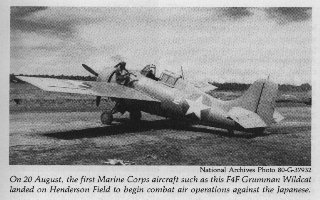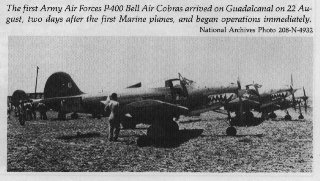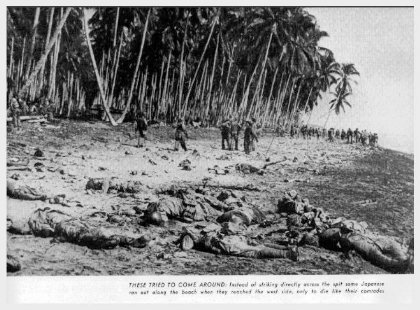*Compiler's Note: The following is a direct transcription
from my father's World War II diary along with some additional material
he wrote in November of 1995. Portion's in italics and quotation marks
are from taped conversations we had over the succeeding months. Some historical
footnotes are taken from World War II Almanac 1931-1945 by Robert
Goralski as well as George McMillan's The Old Breed. "Details" are
taken from Henry I. Shaw's excellent Marines in World War II Commemorative
Series. Photos are both personal and archival. Be advised some pictures
depict the brutal reality of war. - Jim Garrett
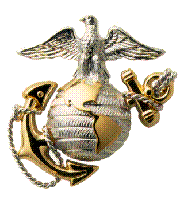
A MARINE DIARY: MY EXPERIENCES ON GUADALCANAL
by
J. R. Garrett
Previous * * * Index
* * * Next
My name is James R. "Rube" Garrett. I was a Corporal,
ammo chief for I Battery, 3rd Battalion, 11th Regiment and a charter member
of the 1st Marine Division, formed in Cuba in 1940. The following are my
diary entries for the Battle of Guadalcanal. A glance through the pages
shows while we were there, 59 enemy air raids flew in. That doesn't include
many false alarms and numerous shellings from Japanese battleships, destroyers
and cruisers. It seemed like about an air raid or shelling every day for
three and a half months. I remember a lot of diving into ditches and ducking
in and out of bomb shelters, or whatever we could find to hide under.
The entry for August 28, 1942, just three weeks
after the landing, reads "...to date, have seen 133 Jap planes fall
and some 20 odd ships sunk." Many more would follow.
These figures are by no means complete. Some pages of
my diary were blank because we were just too busy shooting or being shot
at. We were scared a lot of the time. The weeks and months of anxiety and
tension...long days of tedious work, night watches at the edge of the jungle
suddenly punctuated by sheer terror are only hinted at - if you can read
between the lines. What is there are the impressions of a young 20 year
old Marine just as they were written 53 years ago. They detail the war
in the Solomons as I lived it...one day at a time.
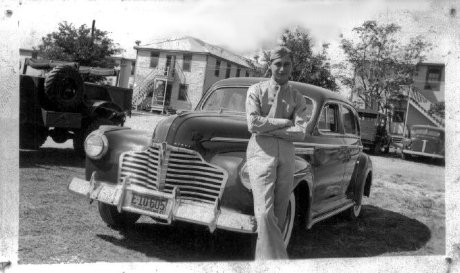 Rube Garrett at Paris Island, September 28, 1941
* * *
Rube Garrett at Paris Island, September 28, 1941
* * *
We sailed from San Francisco on June 22, 1942. I had just
turned 20, and the South Pacific was a long way from Edinburg, Texas, where
I had grown up. Twenty-two days later we landed in Wellington, New Zealand.
It was July 12. We stayed there for a couple of weeks where we, along with
10 or 12 thousand other Marines unloaded our ship, the Erickson,
and loaded onto the Marine Transport USS McCauley.
Preparing for combat, we made several long hikes in New
Zealand to keep us conditioned for what lay ahead. We left New Zealand
on the 21st of July, sailed around the Pacific and made practice landings
on the Fiji Islands. We would disembark from the ship, climb down the nets,
onto the Higgins Boats and go in toward the beach. But we never actually
landed. We would then turn around and return to the ship. We were informed
on August 3rd at a non-commissioned officers conference there, by Lt. Bradbury
(later to become Captain), I Battery Commander, that we were to land on
Guadalcanal in the Solomon Islands. We were going into battle. Ammunition
was issued to all and we spent the rest of the time loading ammunition
belts and getting prepared for combat. On August 6, we were ready.
August 10, 1942
We had machine gun attacks from the rear. Returned fire
for 1500 rounds. Today, drew and belted 50 cal. and issued more 30 cal.
ammunition.
August 11, 1942
Machine gunned again. Sgt. Windish, our Instrument Section
sergeant, was killed accidentally by one of our officers. Went on two hour
patrol with Sgt. Voelker. To river to bathe and saw two prisoners. A friend
of mine, Casey from Headquarters' Battery, was killed in the night, I think
by friendly fire.
"Sgt. Windish was killed accidentally by his own officer,
who was the Instrument Section Commander, with whom he was bunking. He
had left the bunker and, on returning, frightened the man inside who shot
him two times with a 45 caliber pistol. Both men were gone before daylight
- we never saw nor heard of the officer again."
August 12, 1942
Infantry reinforcements at night. We were attacked again
about dawn. Also, naval shelling by subs. Burned off the airfield. Snipers
at dark. Bombers flew over again.
"We had to burn off all the tall Johnson type grass
on Henderson Field - Japanese snipers were using it to slip in amongst
us at night. They would strap a light machine gun to one man's back. He
would run and lay down -- they would fire a few rounds then he would jump
up and the gun would move to another position."
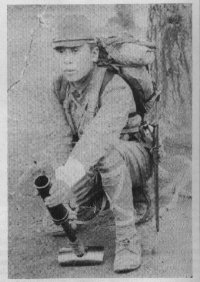 Japanese Knee Mortar
Japanese Knee Mortar
August 13, 1942
Snipers again. Infantry in field. No casualties. Working
parties and our first hot chow in several days.
August 14, 1942
Snipers again. The infantry was firing all night.
Working party for Lt. Williams at Regimental ammo dump. Air raid and the
first anti-aircraft fire. Got sub with 105 Howitzer!
* Our anti-aircraft guns had just been set up. A submarine
had surfaced and began firing on transports. 11th Regiment Howitzers on
the beach opened up on the sub.
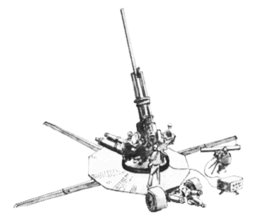 90mm anti-aircraft gun
90mm anti-aircraft gun
* * *
After the first week on Guadalcanal, the 3rd Battalion,
11th Marines were finally settled around the edge of Henderson Field.
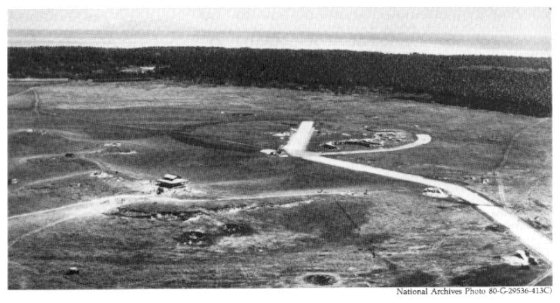 The "Pagoda" at Henderson Field
The "Pagoda" at Henderson Field
In the daytime we were under the protection of the edge
of the jungle. The trees sheltered us from 'Pistol Pete' which was a Japanese
Naval artillery piece that was on tracks in the hills. It would fire two
or three rounds - firing at random all hours of the day - and then would
be rolled back into a cave where it was well camouflaged. It was eventually
located and destroyed a few months later.
At dusk, where we were protected by darkness, we would
move our Howitzers onto the open airfield and point in the direction of
the hills - towards Grassy Knoll, Bloody Ridge and Kukombona. In the open
we could fire in any direction. Then, before daylight, we would pull back
under the trees
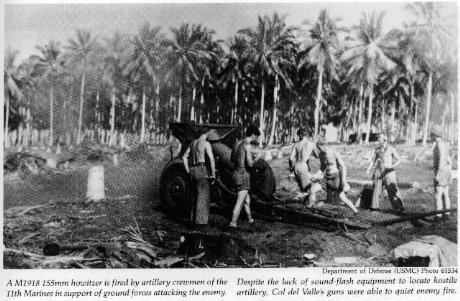
The big disadvantage of living on the airfield as we did
was that it made us a part of the main target - which was the airfield
and aircraft - so that every enemy plane or ship that got within range
either shot at us or dropped bombs on us. We were very fortunate not to
have had lots more casualties than we did.
"I was acting section chief throughout the whole
Guadalcanal engagement...one of the largest sections in the battery. I
had twenty-one or twenty-two guys in my section. Each battery had ten or
twelve or fifteen trucks and jeeps. Take those jeeps and tie a 75 Howitzer
behind the jeep and carry a gun crew on it...a lot of times the gun crew
would have to get off the jeep to help cross a stream; you'd have to break
the gun down and carry it across piece by piece. I imagine those Howitzers
weighed a couple of thousand pounds. It would take three or four men to
carry the barrell and the main block and so on.
Each battery had four Howitzers, four gun crews and
a machine gun section to protect the guns...and that was my section: machine
guns and ammo. I had to keep the guns supplied. My boys had to haul...they'd
be called for ammunition during a mission and we had to deliver ammunition.
Anybody got short of ammunition they'd holler "Garrett!" (laughs).
We had one ton trucks...early on I was a driver, a
Private; it took me eight months to make Pfc. and eighteen months to make
Corporal at Camp Lejeune. As section chief I should have been a Sergeant,
but for some reason advancement in the Marines was slow. Just before we
left Camp Lejeune they were going around asking us if we wanted to apply
for officer's school, but a lot of us 'tough guys' said "Hell no, I don't
want to be an officer."
* * *
August 15, 1942
Quiet except for infantry. Have been hearing firing
from the front lines. Rained from 4am till dawn. Wrote letter. A B-17 from
Australia flew overhead and were we glad to see it! We had a working party
at the beach. And cards.
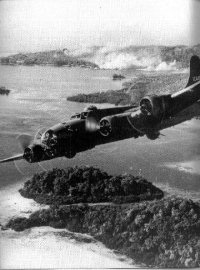 B-17 Flying Fortress on Reconnaisance Patrol
B-17 Flying Fortress on Reconnaisance Patrol
August 16, 1942
Card playing. Church held by C.O. Van Orman. Went to river
for bath. Pretty quiet during the day.
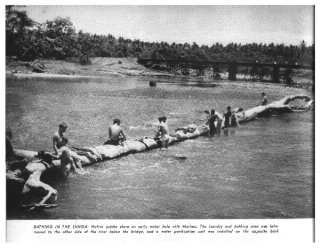 Marines and native scouts at the fallen tree in
the Lunga River
Marines and native scouts at the fallen tree in
the Lunga River
"We always went to the river to bathe - the Lunga River
- it was only knee deep...fresh running water. We'd go in there and strip
off. There was a big old tree, it was laying down in the river. We would
wash our clothes in there and all, lay them on a limb while we swam. And
one time I come back in to the battery and a bomb had fell into I Battery.
Five of our guys were hit but none were killed and they all returned to
duty. But every now and then we'd see a dead Jap floating in the river.
That's the river we fished with hand grenades."
August 17, 1942
Night was quiet. Working party at Regimental ammo
dump. River for bath. Saw three prisoners and three natives. One Jap plane
was overhead all day.
August 18, 1942
Rained all night, not a shot fired. Sgt. Corrigan
slept in our bunker with Kidd and myself. We were the only dry ones in
battery. We registered on a Jap village in the hills. Eight bombers flew
over. Bombs fell on the air field and got some of our boys. Like to have
got us. Raining again.
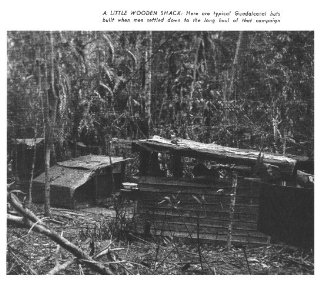 Typical shelter built from scavenged wood
Typical shelter built from scavenged wood
"The Japanese pre-fabbed a three foot by six foot board
arrangement framed with two by twos and planks on the top which we could
lay on top of the ground or in our holes and make a bed. They also had
a sand bag that was woven grass bags of some kind or other and we'd cut
them open and spread them on top and use them for padding on top of these
boards which we used for beds. The boards really helped...we made good
use of whatever the Japanese left behind.We had all of these three by sixes
put together about as big as our tent covers. So we had a wooden floor
under our tent. When somebody would walk across the floor in those boondockers,
with those steel plated heels, sound like a horse walking across a wooden
deck."
August 24, 1942
Our 105 Howitzers fired at a submarine that had fired at our supply
ship, but missed and torpedo came up on beach. Air raid. We shot down 21
Jap planes and lost three.
August 25, 1942
Shelling again during night by sub or cruiser. Went to river for bath
and visited my friend Wilcox, who was in special weapons battery. Air raid
and close call in Willie's foxhole. Went swimming and saw one of our planes
crash.
August 26, 1942
Quiet at night. Air raid at breakfast. Dogfights and six planes fell.
Bombs fell on airfield and in coconut grove. Seven Zero's - we lost one.
Bombs fell on G Battery - got three men.
August 27, 1942
Pfc. Bonnano from my section in hospital. False air raid alarm.
August 28, 1942
All quiet. Army supposed to show up but didn't. Up to date, have seen
133 Jap planes fall and some 20 odd ships sunk.
August 29, 1942
First night bombing that we have had. Two before dawn. Killed two men
in H & S* Battery and wounded Spernack. Killed Zagury of HQ Battery.
Air raid at noon. We shot down eight planes.
*Headquarters and Services Battery
August 30, 1942
False alarm at one o'clock. They come at noon though and dropped bombs
at edge of field. I had the 10 to 12 watch.
 This is Henderson Field as seen from above. Note bomb craters around
the runway.
This is Henderson Field as seen from above. Note bomb craters around
the runway.
August 31, 1942
On 12 to 2 watch. Two air raids and one destroyer of ours was hit by
dive bomber. Humphrey.
*The ship was the Navy Destroyer USS Humphrey.










